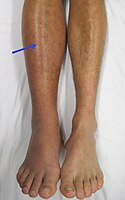
Photo from wikipedia
In lung ultrasound (LUS), the interactions between the acoustic pulse and the lung surface (including the pleura and a small subpleural layer of tissue) are crucial. Variations of the peripheral… Click to show full abstract
In lung ultrasound (LUS), the interactions between the acoustic pulse and the lung surface (including the pleura and a small subpleural layer of tissue) are crucial. Variations of the peripheral lung density and the subpleural alveolar shape and its configuration are typically connected to the presence of ultrasound artifacts and consolidations. COVID-19 pneumonia can give rise to a variety of pathological pulmonary changes ranging from mild diffuse alveolar damage (DAD) to severe acute respiratory distress syndrome (ARDS), characterized by peripheral bilateral patchy lung involvement. These findings are well described in CT imaging and in anatomopathological cases. Ultrasound artifacts and consolidations are therefore expected signs in COVID-19 pneumonia because edema, DAD, lung hemorrhage, interstitial thickening, hyaline membranes, and infiltrative lung diseases when they arise in a subpleural position, generate ultrasound findings. This review analyzes the structure of the ultrasound images in the normal and pathological lung given our current knowledge, and the role of LUS in the diagnosis and monitoring of patients with COVID-19 lung involvement.
Journal Title: Diagnostics
Year Published: 2022
Link to full text (if available)
Share on Social Media: Sign Up to like & get
recommendations!